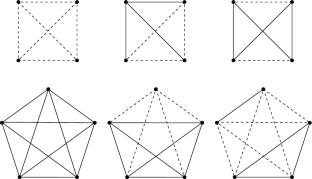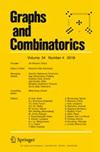有符号的拉姆齐数字
IF 0.6
4区 数学
Q3 MATHEMATICS
引用次数: 0
摘要
让 r(s, t) 是经典的双色拉姆齐数;也就是说,最小的整数 n,使得任何边的双色 \(K_n\) 包含颜色 1 的单色 \(K_s\) 或颜色 2 的单色 \(K_t\)。定义有符号的拉姆齐数(r_\pm (s,t)\)是最小的整数 n,对于这个整数,\(K_n\)的任何符号都有一个切换到\(-K_s\)或\(+K_t\)的子图。我们证明了以下结果。(1)\(r_\pm (s,t)=r_\pm (t,s)\)(2)\(r_\pm (s,t)\ge \left\lfloor \frac{s-1}{2}\right\rfloor (t-1)\)(3)\(r_\pm (s、(4)(r_\pm (3,t)=t)(5)(r_\pm (4,4)=7)(6)(r_\pm (4,5)=8)(7)(r_\pm (4,6)=10)(8)(3\!\left\lfloor \frac{t}{2}\right\rfloor \le r_\pm (4,t+1)\le 3t-1\)本文章由计算机程序翻译,如有差异,请以英文原文为准。

Signed Ramsey Numbers
Let r(s, t) be the classical 2-color Ramsey number; that is, the smallest integer n such that any edge 2-colored \(K_n\) contains either a monochromatic \(K_s\) of color 1 or \(K_t\) of color 2. Define the signed Ramsey number \(r_\pm (s,t)\) to be the smallest integer n for which any signing of \(K_n\) has a subgraph which switches to \(-K_s\) or \(+K_t\). We prove the following results.
-
(1)
\(r_\pm (s,t)=r_\pm (t,s)\)
-
(2)
\(r_\pm (s,t)\ge \left\lfloor \frac{s-1}{2}\right\rfloor (t-1)\)
-
(3)
\(r_\pm (s,t)\le r(s-1,t-1)+1\)
-
(4)
\(r_\pm (3,t)=t\)
-
(5)
\(r_\pm (4,4)=7\)
-
(6)
\(r_\pm (4,5)=8\)
-
(7)
\(r_\pm (4,6)=10\)
-
(8)
\(3\!\left\lfloor \frac{t}{2}\right\rfloor \le r_\pm (4,t+1)\le 3t-1\)
求助全文
通过发布文献求助,成功后即可免费获取论文全文。
去求助
来源期刊

Graphs and Combinatorics
数学-数学
CiteScore
1.00
自引率
14.30%
发文量
160
审稿时长
6 months
期刊介绍:
Graphs and Combinatorics is an international journal devoted to research concerning all aspects of combinatorial mathematics. In addition to original research papers, the journal also features survey articles from authors invited by the editorial board.
 求助内容:
求助内容: 应助结果提醒方式:
应助结果提醒方式:


